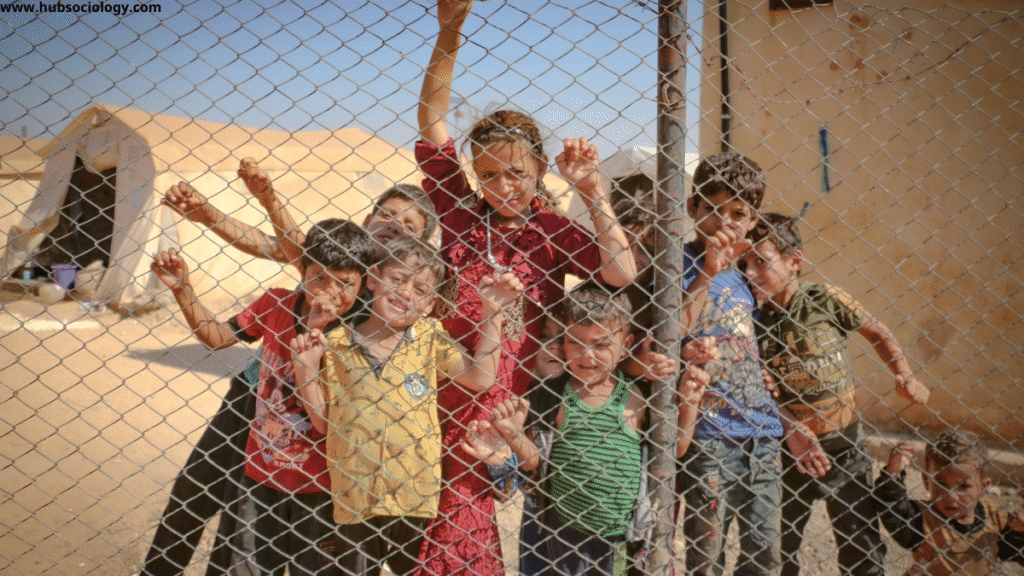Introduction
Georg Simmel (1858–1918), a founding figure in sociology, is often celebrated for his unique approach that fused philosophy, sociology, and cultural analysis. Unlike many of his contemporaries such as Karl Marx, Émile Durkheim, or Max Weber, Simmel focused less on grand social structures and more on everyday interactions and patterns of association. His sociology is often termed formal sociology because he sought to uncover the recurring forms through which human beings interact, regardless of the content or specific historical circumstances.
Within this framework, one of Simmel’s most influential contributions is his concept of “social types.” Social types are not individuals themselves, but rather patterns of personhood that emerge through recurring interactions in society. These types represent how society perceives and positions individuals, and how individuals take on specific roles within the complex web of social relationships.
Simmel’s exploration of social types illuminates the way individuality and society interpenetrate: the individual both shapes and is shaped by the collective. By analyzing these recurring social roles, Simmel provides a nuanced understanding of how personal identity, social function, and collective norms intersect.

The Concept of Social Types
Simmel introduced social types as abstract categories that reflect recurring roles individuals occupy in social life. Unlike psychological personality types, which attempt to describe internal traits, social types describe positions, relationships, and functions within social interactions.
For Simmel, every social type is a social construct, emerging out of interactions. An individual becomes a type not by innate qualities but through their relation to others. Thus, “the stranger,” “the mediator,” or “the poor” are not just descriptive labels; they embody the ways society defines, expects, and interacts with certain roles.
Social types are significant because they reveal:
- The objectivity of social roles – roles exist beyond the individual, waiting to be filled.
- The fluidity of identity – individuals may shift between types depending on context.
- The sociological imagination – types bridge the personal and the collective, showing how individuality is shaped by interaction.
Major Social Types Identified by Simmel
Simmel identified multiple social types in his writings. Each reveals how social forms manifest in different roles and contexts. Some of the most notable include:
1. The Stranger
Perhaps Simmel’s most famous social type is “the stranger.” Unlike the foreigner who comes and leaves, the stranger is someone who comes today and stays tomorrow. This type symbolizes both nearness and remoteness.
- The stranger belongs to the group but remains outside it, creating a paradoxical position.
- This type often arises in roles such as merchants, traders, or immigrants, who participate in economic and cultural exchange but are not fully assimilated.
- The stranger represents the broader theme of social distance—a critical concept in Simmel’s sociology.
The importance of the stranger lies in how it reflects ambivalence: society needs outsiders for novelty, trade, and fresh perspectives, but simultaneously marks them as different and distant.
2. The Mediator
The mediator is the individual who resolves conflict, negotiates differences, or connects groups that would otherwise remain apart.
- This type arises in contexts such as diplomacy, legal arbitration, or family disputes.
- The mediator embodies the form of triadic interaction—where the presence of a third party changes the dynamics of a dyad.
- For Simmel, mediation is not only about resolving disputes but also about enabling new forms of unity.
The mediator type demonstrates how individuals can transcend conflict through role-specific interaction, showing the constructive potential of social forms.
3. The Poor
Simmel defined the poor not simply as individuals lacking resources, but as a social category created through relationships of assistance.
- Poverty is not just an economic condition but a relational identity formed through dependence, aid, and exclusion.
- Society perceives “the poor” as a type when individuals are recipients of institutional or communal support.
- This social type highlights how material deprivation is socially recognized and institutionally managed.
Thus, “the poor” is less about personal identity and more about how society positions individuals in relation to others.

4. The Adventurer
The adventurer is a type who lives in the present moment, engaging in extraordinary, unpredictable experiences that stand outside routine life.
- The adventurer represents freedom from convention, yet paradoxically, this role itself becomes a recognizable type.
- They often embody excitement, danger, and disruption, existing on the margins of settled social life.
- The adventurer provides society with contrast—reminding others of possibilities beyond normality.
This type symbolizes the tension between stability and spontaneity in human life.
5. The Renegade
The renegade is the one who breaks away from established norms or groups to which they once belonged.
- Unlike the stranger, who is an outsider from the beginning, the renegade is an insider who withdraws.
- This type embodies betrayal, transformation, and independence.
- The renegade forces society to confront its boundaries by rejecting its norms.
Here, Simmel reveals how deviation and rebellion are also constitutive of social life.
Sociological Importance of Social Types
Simmel’s notion of social types carries significant sociological implications:
- Revealing Social Forms – By identifying recurring types, Simmel shows how society organizes itself through stable yet flexible patterns.
- Bridging Individual and Society – Social types demonstrate how individuality is never isolated; it is socially constructed through interaction.
- Understanding Modernity – In the context of modern urban life, where anonymity and diversity flourish, these types help explain the complexity of social relationships.
- Role Fluidity – Unlike rigid caste or class categories, Simmel’s types suggest that individuals may occupy different positions depending on time, place, and context.
- Critical Reflection – By analyzing roles such as the poor or the stranger, Simmel invites reflection on exclusion, inequality, and the ambivalence of social integration.
Criticisms of Simmel’s Approach
While influential, Simmel’s concept of social types is not without criticism:
- Lack of Structural Analysis – Critics argue that Simmel focuses too much on micro-level interactions without fully addressing broader structures of power and economy.
- Overly Abstract – The types are often generalized and lack empirical grounding in specific societies.
- Neglect of Change – Some argue Simmel emphasizes recurring forms rather than historical transformations of roles.
Nevertheless, these criticisms also underscore the originality of Simmel’s approach, which deliberately sought to complement, rather than replicate, structural sociology.
Relevance in Contemporary Sociology
Despite being over a century old, Simmel’s idea of social types remains relevant today.

- Globalization and Migration – The figure of the stranger resonates in discussions of refugees, migrants, and diasporic communities.
- Conflict Resolution – The mediator remains central in fields from international relations to workplace dynamics.
- Poverty Studies – Defining “the poor” as a social relation rather than merely an economic status echoes in debates on welfare, social policy, and marginalization.
- Cultural Studies – The adventurer and renegade connect to contemporary themes of subcultures, countercultures, and individualism.
Simmel’s framework thus provides valuable tools to interpret modern complexities.
Conclusion
Georg Simmel’s concept of social types reflects his broader vision of sociology as a study of forms and interactions. By identifying recurring roles such as the stranger, the mediator, the poor, the adventurer, and the renegade, Simmel highlighted the ways individuals embody collective meanings and how society structures its expectations through interaction.
Though abstract, these types reveal enduring truths about social life: individuals are not isolated beings but carriers of roles shaped by collective recognition. In modern contexts of globalization, inequality, and cultural diversity, Simmel’s social types remain a powerful lens through which to examine the intersections of individuality and society.
Ultimately, Simmel reminds us that to understand society, we must not only examine institutions and structures but also the forms of human interaction that weave individuals into the collective fabric.
Do you like this this Article ? You Can follow as on :-
Facebook – https://www.facebook.com/hubsociology
Whatsapp Channel – https://whatsapp.com/channel/0029Vb6D8vGKWEKpJpu5QP0O
Gmail – hubsociology@gmail.com
Exam-Style Questions on Social Types by Georg Simmel
5 Marks Questions (Short Answer)
- Define the term “social types” as used by Georg Simmel.
- Briefly explain the significance of “the stranger” as a social type.
- How does Simmel distinguish the poor as a social type?
- What is the role of the mediator in social interactions according to Simmel?
- Mention two key features of Simmel’s approach to social types.
10 Marks Questions (Medium Answer)
- Discuss the sociological significance of “the stranger” in Simmel’s analysis. Provide examples.
- Explain how Simmel’s concept of the poor shows that poverty is a social relationship rather than an individual condition.
- Compare and contrast the roles of the mediator and the renegade as social types.
- Evaluate the relevance of Simmel’s social types in the study of modern urban societies.
- How do Simmel’s social types demonstrate the relationship between individuality and society?
15 Marks Questions (Long Answer / Essay)
- Critically analyze Georg Simmel’s concept of social types with reference to “the stranger,” “the mediator,” and “the poor.”
- Examine the role of the adventurer and the renegade as social types in reflecting individuality and deviation from norms.
- Discuss the strengths and limitations of Simmel’s approach to social types in the broader framework of classical sociology.
- How do Simmel’s social types help us understand contemporary issues such as migration, globalization, and poverty?
- “Simmel’s social types reveal the recurring patterns of human interaction that transcend time and place.” — Discuss with examples.
